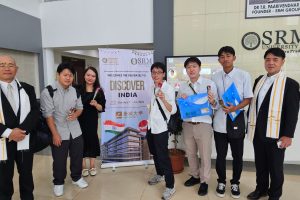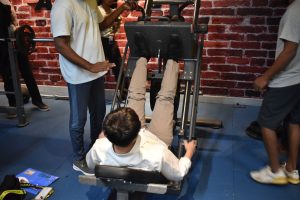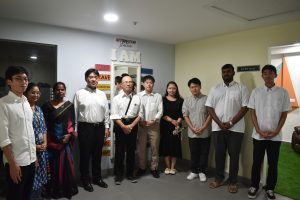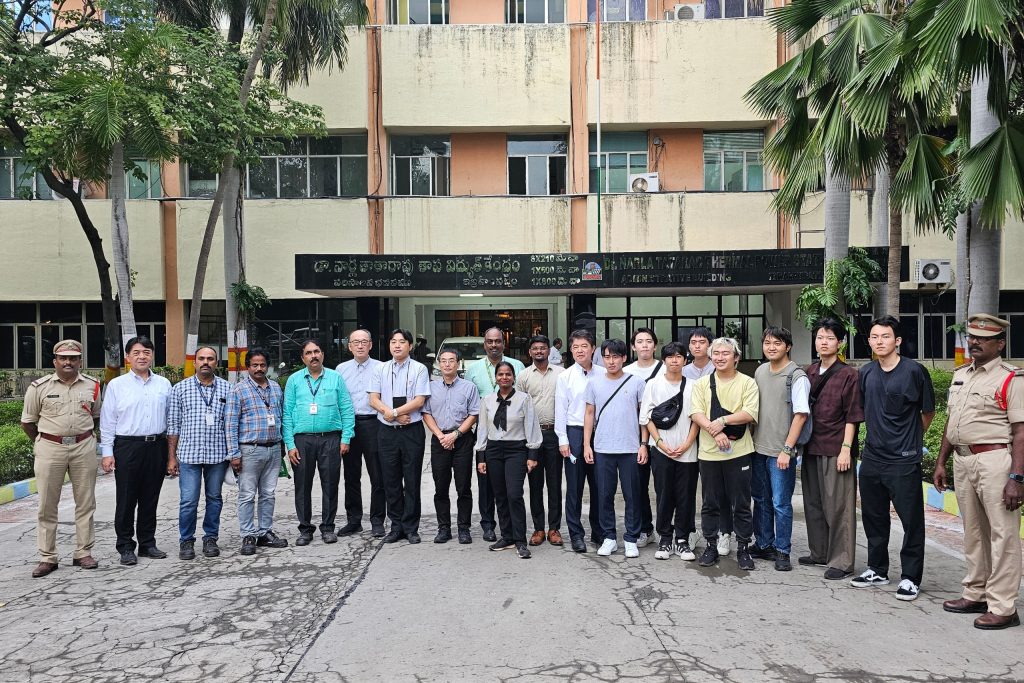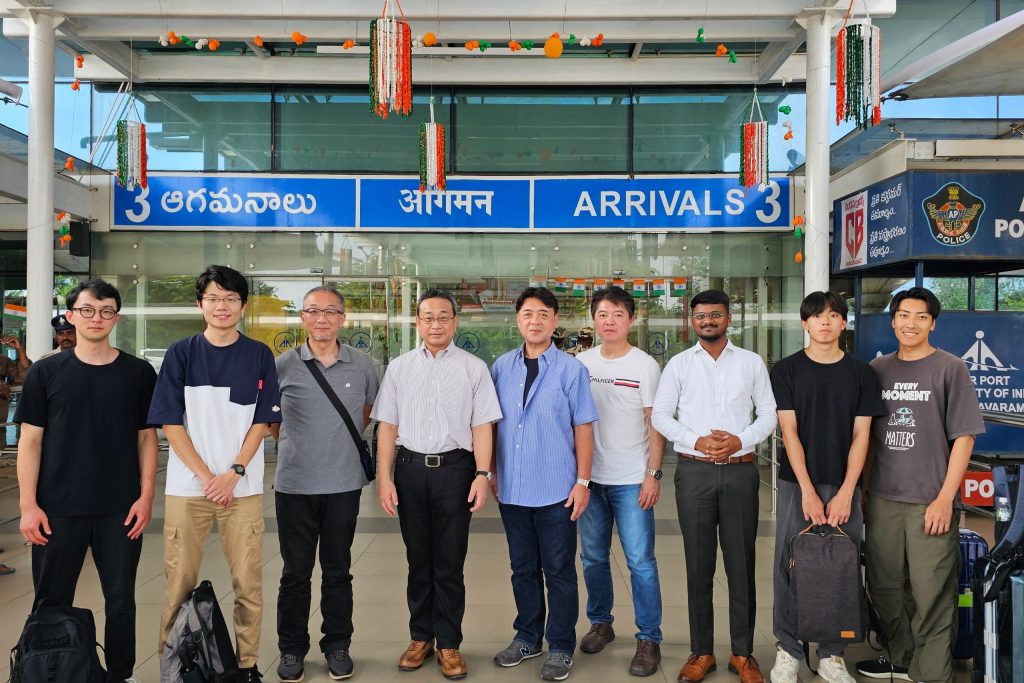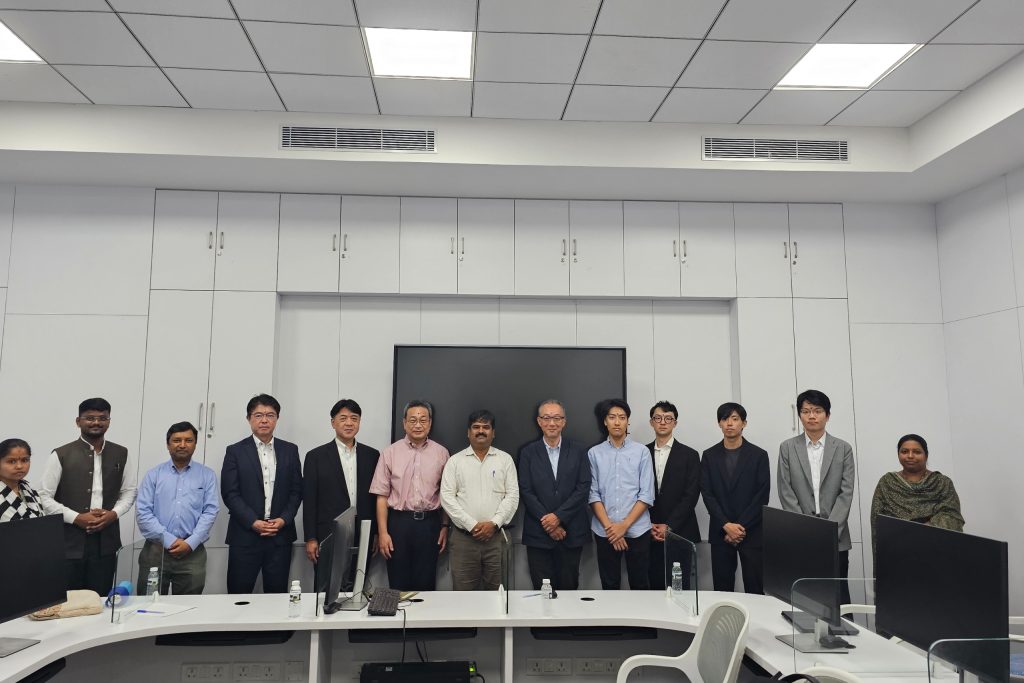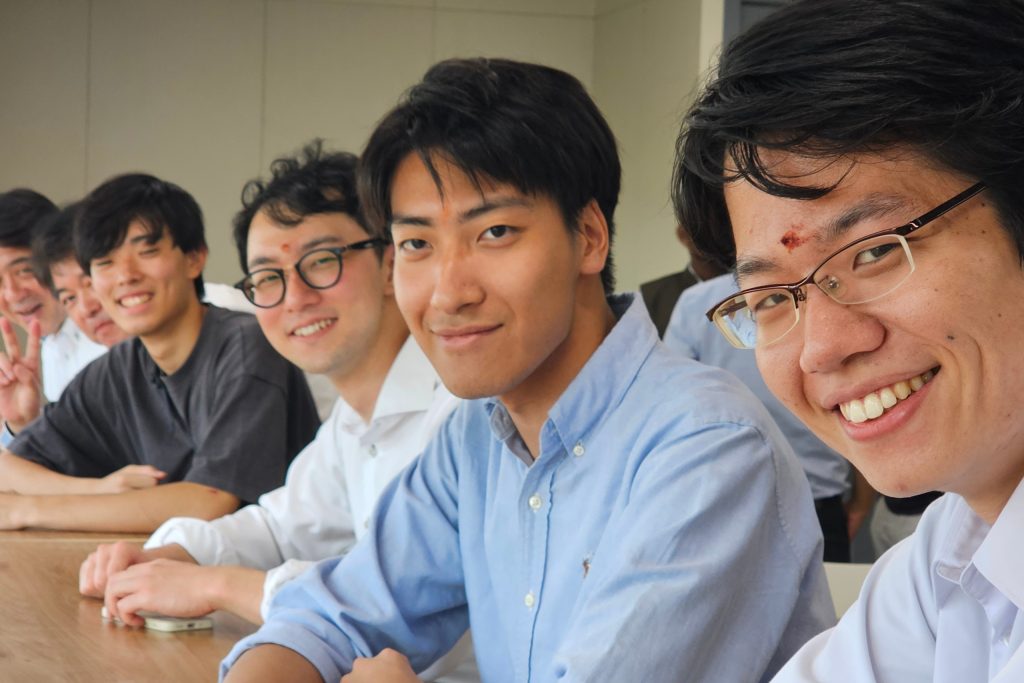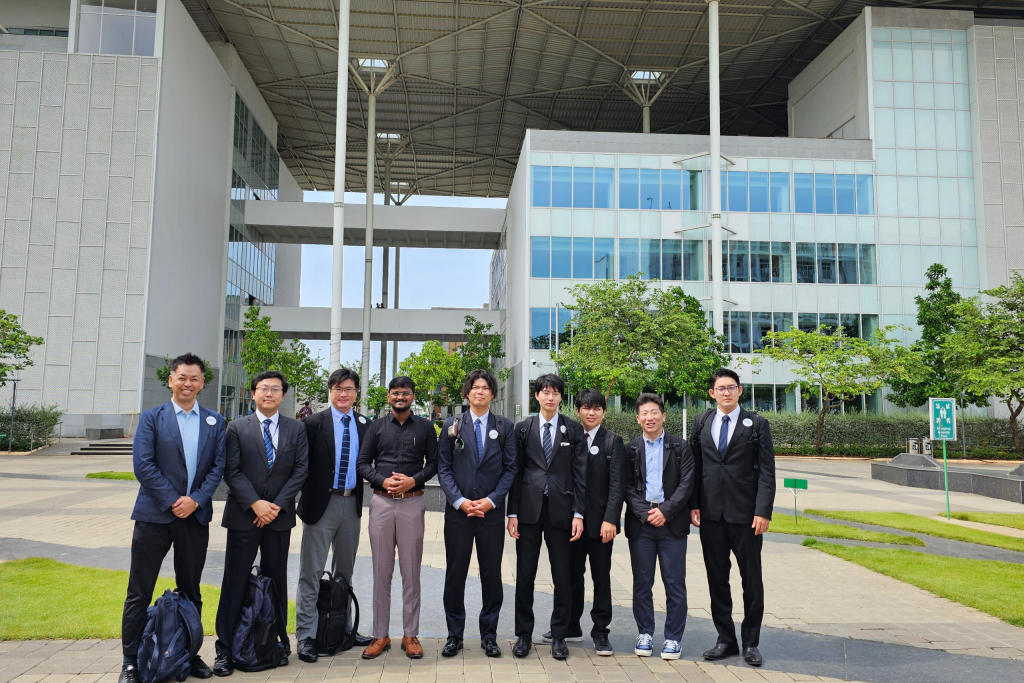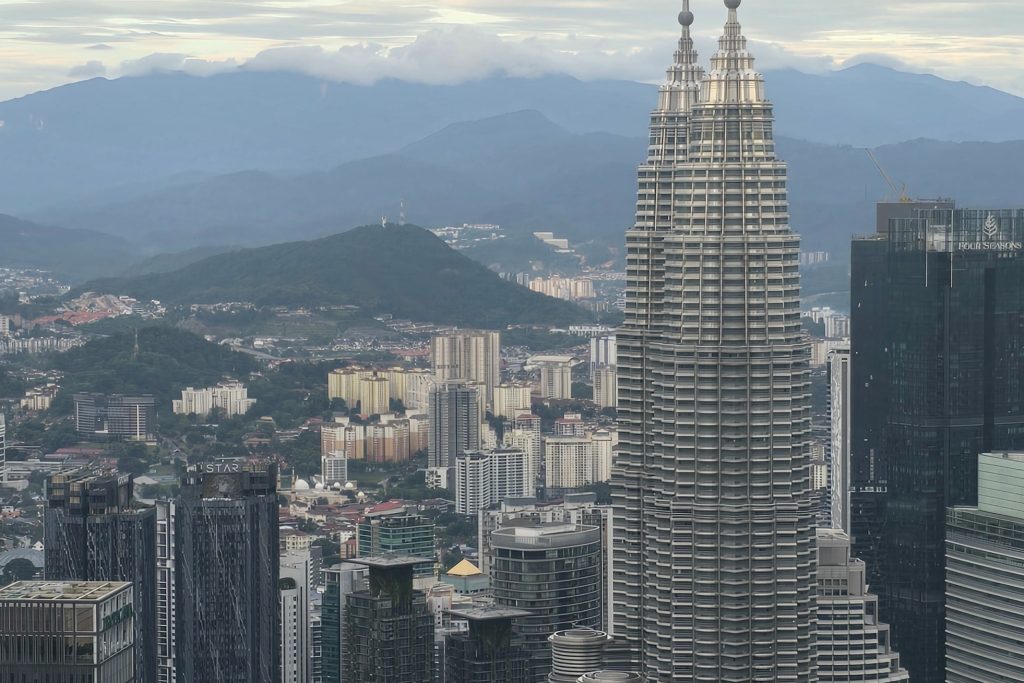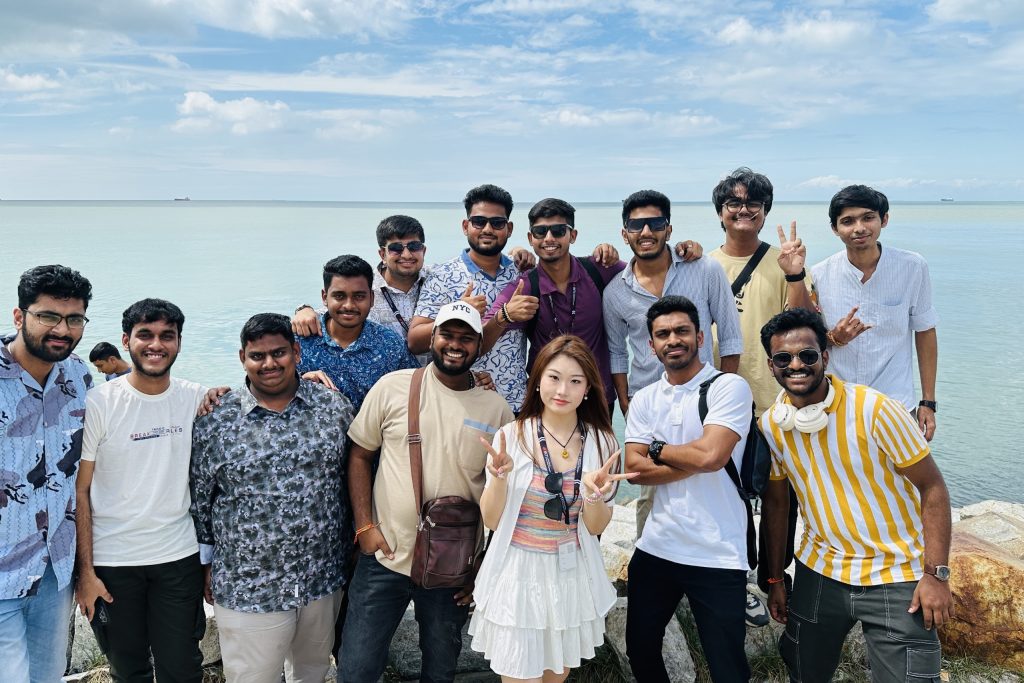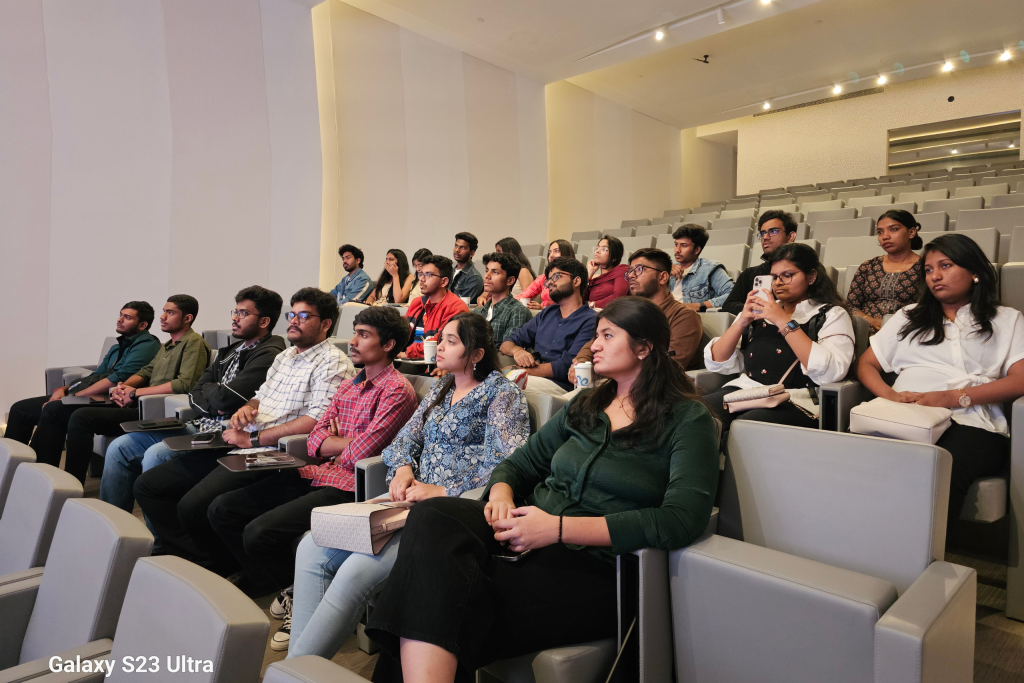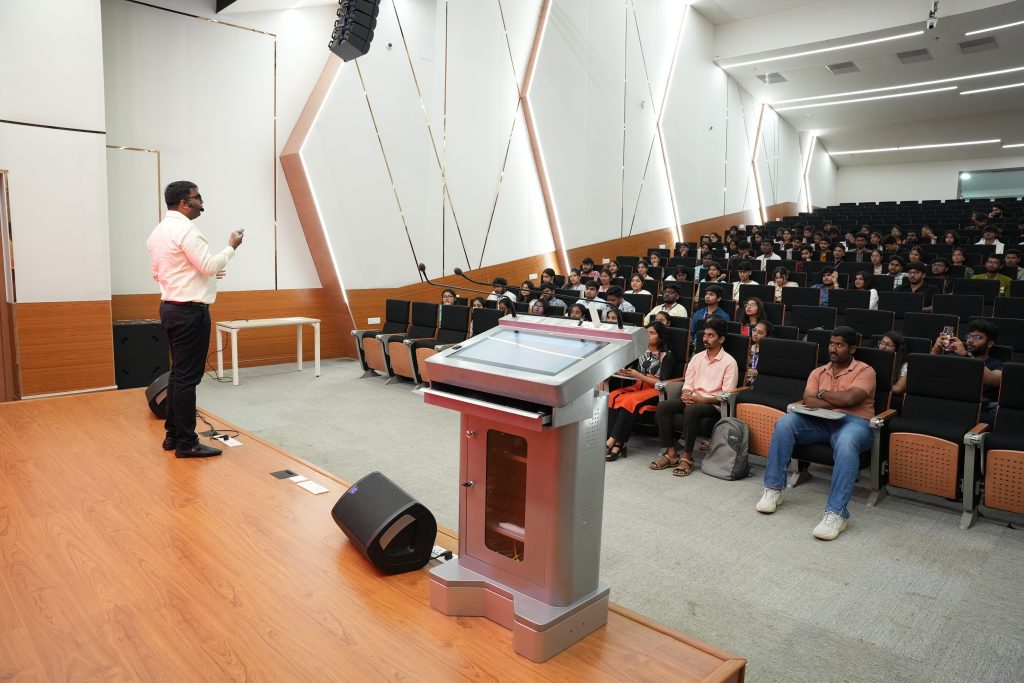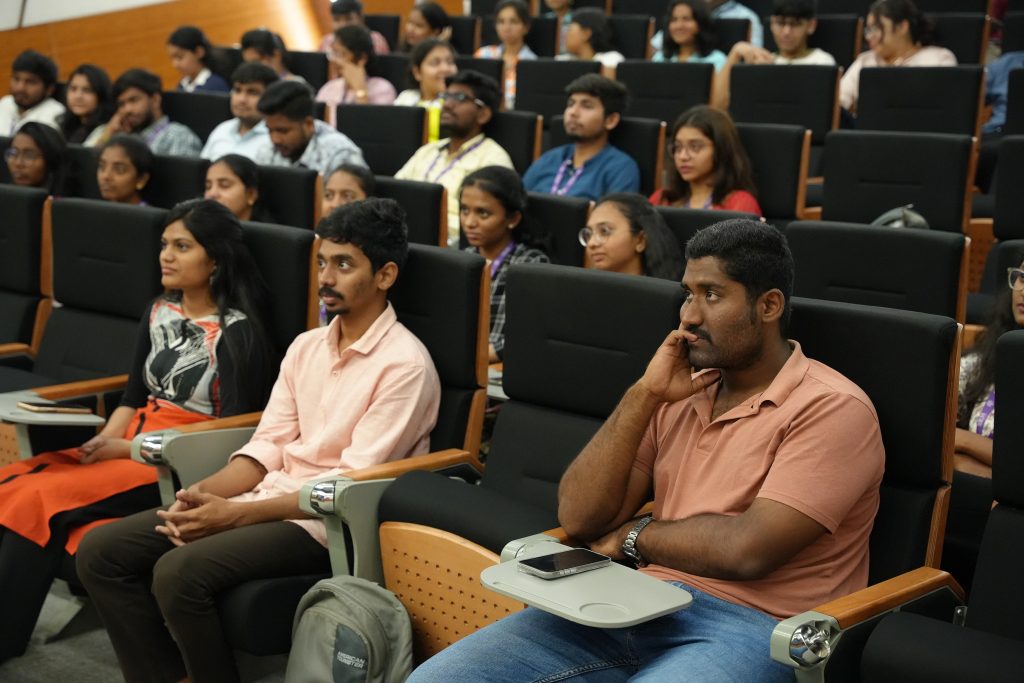SOJO University
 The Directorate of International Relations & Higher Studies organized a “Discover India 2024 ” program for professors and students from Sojo University and Forum Engineering, Japan.
The Directorate of International Relations & Higher Studies organized a “Discover India 2024 ” program for professors and students from Sojo University and Forum Engineering, Japan.
Inaugurated by the honorable Vice Chancellor of SRM University-AP, Prof. Manoj K Arora, Bharadhwaj Sivakumaran, Jatindra Kumar Dash, Jayaseelan Murugaiyan. Dr. Sudeshna Saha, Assistant Director of International Relations and Higher Studies, received the international students at the grand inaugural ceremony of the program. Students participated in various short courses on research area introduction Research Lab and Centre Visit from Prof. Ranjit Thapa, Physics working Labs, Dr. Basabendu Barman and Dr. L N Patro, Research work presentations from Department of Chemistry & Biology. They had Chart activity on Environmental Science from Dr. Narayanamoorthy Bhuvanendran Department of Environmental Science and Engineering.
A discussion was held with the IR & HS team and leadership team regarding various mobility programs, including Student and Faculty Exchange, Transfer Programs, Joint Research initiatives, and opportunities for mutual collaboration between Tokyo University and SRM University AP.
An interactive session was organized for Destination Japan students currently learning Japanese at SRM University AP, supported by SRM Global. Professors Tomoshige Ryuichi delivered an engaging presentation on Tokai University, highlighting job and internship opportunities in Japan. The session provided a platform for Destination Japan students to interact with peers learning Japanese. Over 40 students actively participated, making the event a resounding success.
The industrial visit saw participation from a total of 12 members, including 1 professor, 1 staff member, and 5 students from Sojo University and Forum Engineering, as well as 2 staff members and 2 students from SRM University AP. As part of the 3-day “Discover India” program, SRM University AP organized an industrial visit on October 8th 2024, for the Japanese delegation from Sojo University and Forum Engineering. The group visited the “Jocil Limited ” located in Guntur. Jocil Limited work for Manufacturing Toilet Soap/ Soap Noodles/ Coloured Noodles/ Strands and Bits/ Premium and Translucent Soaps/ Liril Icy Cool l Savlon l Margo Natural and brands have been developed at Jocil.
First we have a brief introduction of the team, followed by a presentation on the Guntur plant. After that we visited to Fatty Acid Fractionation Plant, Fatty Acid Splitting Plant, Soap Plant – Vacuum Spray Drying,Boiling Section, Vacuum Spray Drying, Wrapping Machines, Semi Automatic and visited soap Finishing Section STUR 7 Stamping M/C.
Following this, the students were taken to the simulation room, where they observed the production process of Thumbs Up and other flavored beverages. They then toured various sections of the plant to see how different drinks are bottled and packed.
They also got to visit the famous landmarks of Vijayawada, such as the Dhyana Buddha statue, Prakasham Barrage, Vijayawada Kanaka Durga Temple etc.
- Published in Departmental News, IR-News, News
Hiroshima & Chiba Institute of Technology
 The Directorate of International Relations & Higher Studies organized a “Discover India 2024 ” program for professors and students from Hiroshima & Chiba Institute of Technology and Forum Engineering, Japan.
The Directorate of International Relations & Higher Studies organized a “Discover India 2024 ” program for professors and students from Hiroshima & Chiba Institute of Technology and Forum Engineering, Japan.
The 4-day program conducted by the Directorate of International Relations and Higher Studies was inaugurated by the honourable Vice Chancellor of SRM University-AP, Prof. Manoj K Arora, Bharadhwaj Sivakumaran, Jatindra Kumar Dash, Jayaseelan Murugaiyan. “Discover India 2024” is a flagship initiative of the university to promote India’s cultural and knowledge traditions.
Dr. Sudeshna Saha, Assistant Director of International Relations and Higher Studies, received the international students at the grand inaugural ceremony of the program. Students participated in various short courses on research area introduction Mechanical Engineering/ Lab and Centre Visit, Electronic Cooling Lab, Computer Science and Engineering and visit to Research Lab’s. Presentations on Robotics, Additive Manufacturing & Bio Printing, Materials by Prof. G S Vinod Kumar HOD – Department of Mechanical
A discussion was held with the IR & HS team and with the leadership team regarding various mobility programs, including Student and Faculty Exchange, Transfer Programs, Joint Research initiatives, and opportunities for mutual collaboration between Tokyo University and SRM University AP.
An interactive session was organized for Destination Japan students currently learning Japanese at SRM University AP, supported by SRM Global. Professors Tomoaki Yatsufusa delivered an engaging presentation on Tokai University, highlighting job and internship opportunities in Japan. The session provided a platform for Destination Japan students to interact with peers learning Japanese. Over 40 plus students actively participated, making the event a resounding success.
The industrial visit saw participation from a total of 18 members, including 3 professors, 2 staff members, and 8 students from Chiba & Hiroshima Institute of Technology and Forum Engineering, as well as 3 staff members and 2 students from SRM University AP. As part of the 3-day “Discover India” program, SRM University AP organized an industrial visit on September 22, 2024, for the Japanese delegation from Tokai University and Forum Engineering. The group visited the Dr. Narla Tata Rao Thermal Power Station in Ibrahimpatnam. The power plant is one of the coal-based power plants of APGENCO.
The visit began with a brief introduction of the team, followed by a presentation on the Ibrahimpatnam Coal-Based Power Station. After the presentation, the group toured the entire power station, including the coal heating and cooling units, gaining an understanding of the coal-based power generation process and how electricity is supplied to the Vijayawada region.
They also got to visit the famous landmarks of Vijayawada, such as the Dhyana Buddha statue, Prakasham Barrage, Vijayawada Kanaka Durga Temple etc.
- Published in Departmental News, IR-News, News
Discover India 2024: Tokyo University
 The Directorate of International Relations & Higher Studies welcomed the students and faculty from Tokyo University and Forum Engineering, Japan for “Discover India 2024 ” program
The Directorate of International Relations & Higher Studies welcomed the students and faculty from Tokyo University and Forum Engineering, Japan for “Discover India 2024 ” program
Inaugurated by the honorable Vice Chancellor of SRM University-AP, Prof. Manoj K Arora, Bharadhwaj Sivakumaran, Jatindra Kumar Dash, Jayaseelan Murugaiyan. Mr. Lakshmi Narasimhan Director (In-Charge) and Dr. Sudeshna Saha, Assistant Director of International Relations and Higher Studies, received the international students at the grand inaugural ceremony of the program. Students participated in various short courses on research area introduction (Electronic Cooling Lab), Mechanical Engineering Labs and Centre Visit (Electronic Cooling & Gold Centre) Presentations on Robotics, Additive Manufacturing & Bio Printing, Materials – Prof. G S Vinod Kumar HOD – Department of Mechanical.
A discussion was held with the IR & HS team and leadership team regarding various mobility programs, including Student and Faculty Exchange, Transfer Programs, Joint Research initiatives, and opportunities for mutual collaboration between Tokyo University and SRM University AP.
An interactive session was organized for Destination Japan students currently learning Japanese at SRM University AP, supported by SRM Global. Professors Tsutomu Iida and Kohei Soga delivered an engaging presentation on Tokai University, highlighting job and internship opportunities in Japan. The session provided a platform for Destination Japan students to interact with peers learning Japanese. Over 40 plus students actively participated, making the event a resounding success.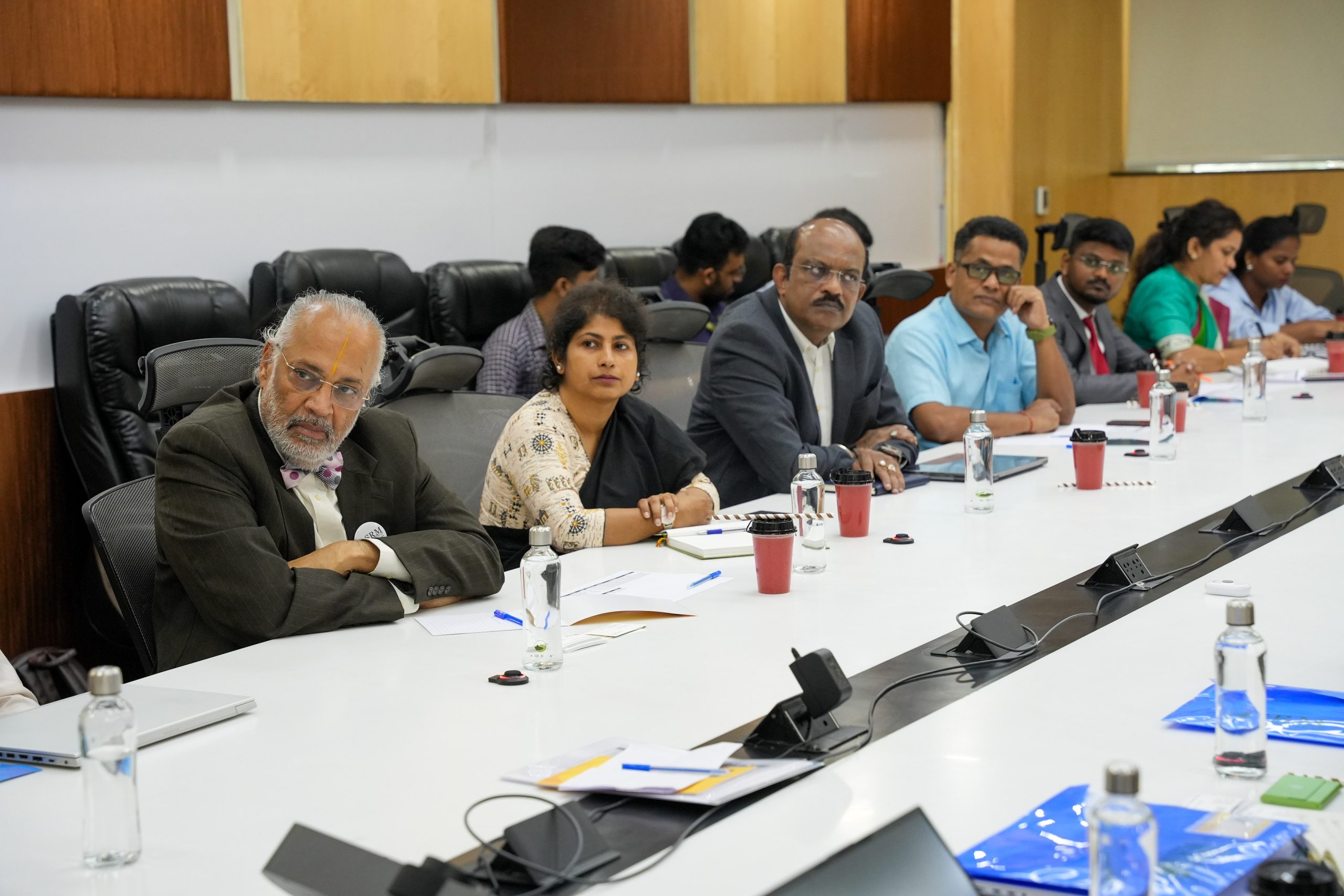
The industrial visit saw participation from a total of 13 members, including 2 professors, 2 staff members, and 4 students from Tokyo University and Forum Engineering, as well as 3 staff members and 2 students from SRM University AP. As part of the 3-day “Discover India” program, SRM University AP organized an industrial visit on August 22, 2024, for the Japanese delegation from Tokai University and Forum Engineering. The group visited the Industry Visit to Efftronics Systems Pvt. Ltd, Company work on 3 services like IOT services/ Customer services and product development services.
Professor and students have visited the product development services unit and understand the process development process and their experiences. We focus on idea generation to translate problems into solutions. We explore a wide variety and large quantity of ideas to go beyond the obvious solutions to a problem. We use a simple, economical cost and fast way to shape ideas, so you can experience and interact with them.
- Published in Departmental News, IR-News, News
Tokai University
 The Directorate of International Relations & Higher Studies organized a “Discover India 2024” program for professors and students from Tokai University and Forum Engineering, Japan. The 4-day programme conducted by the Directorate of International Relations and Higher Studies was inaugurated by the honourable Vice Chancellor of SRM University-AP, Prof. Manoj K Arora, Bharadhwaj Sivakumaran, Jatindra Kumar Dash, Jayaseelan Murugaiyan. “Discover India 2024” is a flagship initiative of the university to promote India’s cultural and knowledge traditions.
The Directorate of International Relations & Higher Studies organized a “Discover India 2024” program for professors and students from Tokai University and Forum Engineering, Japan. The 4-day programme conducted by the Directorate of International Relations and Higher Studies was inaugurated by the honourable Vice Chancellor of SRM University-AP, Prof. Manoj K Arora, Bharadhwaj Sivakumaran, Jatindra Kumar Dash, Jayaseelan Murugaiyan. “Discover India 2024” is a flagship initiative of the university to promote India’s cultural and knowledge traditions.
Dr. Sudeshna Saha, Assistant Director of International Relations and Higher Studies, received the international students at the grand inaugural ceremony of the program. Students participated in various short courses on research area introduction (Electronic Cooling Lab), Mechanical Engineering Labs and Centre Visit (Electronic Cooling & Gold Centre) Presentations on Robotics, Additive Manufacturing & Bio Printing, Materials – Prof. G S Vinod Kumar HOD – Department of Mechanical.
A discussion was held with the IR & HS team and with the leadership team regarding various mobility programs, including Student and Faculty Exchange, Transfer Programs, Joint Research initiatives, and opportunities for mutual collaboration between Tokyo University and SRM University AP.
An interactive session was organized for Destination Japan students currently learning Japanese at SRM University AP, supported by SRM Global. Professors Kazuyoshi Tsuchiya and Tomoyuki Ikeda delivered an engaging presentation on Tokai University, highlighting job and internship opportunities in Japan. The session provided a platform for Destination Japan students to interact with peers learning Japanese. Over 47 students actively participated, making the event a resounding success.
The industrial visit saw participation from a total of 10 members, including 2 professors, 1 staff member, and 5 students from Tokai University and Forum Engineering, as well as 2 staff members from SRM University AP. As part of the “Discover India” program, SRM University AP organized an industrial visit on August 8, 2024, for the Japanese delegation from Tokai University and Forum Engineering. The group visited the Coca-Cola factory, where they first interacted with the head of the department and watched an instructional video outlining the guidelines and safety precautions for the tour.
Following this, the students were taken to the simulation room, where they observed the production process of Thumbs Up and other flavored beverages. They then toured various sections of the plant to see how different drinks are bottled and packed.
They also got to visit the famous landmarks of Vijayawada, such as the Dhyana Buddha statue, Prakasham Barrage, Vijayawada Kanaka Durga Temple etc.
- Published in Departmental News, IR-News, News
Alpine Secondary School
SRM University-AP with its goal and vision of internationalization, also opens the door for the students who aspire to study in India. SRM AP being one of the known and finest universities in India would love to host students and staff across the globe. Its fascinating infrastructure, its globally accepted curriculum, its highly experienced faculties to its wider partnerships worldwide, give a magnificent opportunity to the students.
SRM University-AP welcomed the students and faculty of the Alpine Secondary School, Nepal to the rich cultural landscape of India through the Aadigyan – Summer Youth Program 2023. The 4-day program conducted by the Directorate of International Relations and Higher Studies was inaugurated by the honorable Vice Chancellor of SRM University-AP, Prof. Manoj K Arora, vishnupad mishra, Bharadhwaj Sivakumaran, Jatindra Kumar Dash, Jayaseelan Murugaiyan, Dr. Tousif Khan N, SMIEEE, MIE Dr.Srabani Basu Sidharth Tripathy, Mahesh Kumar Ravva, Ranjit Thapa
Ms. Adity Jain, Director of International Relations and Higher Studies, received the international students at the grand inaugural ceremony of the program. Students participated in various short courses on Future Prospects and Introduction Unraveling Future Pathways – Dr. Tousif Khan, HOD – EEE, Walk with the Scientist – Prof Jayaseelan Assoc Dean, SEAS-Sciences, Liberal Arts Unveiled: Navigating Future Avenues – Dr Srabani Basu, HOD – English, Business Insight: Today and Beyond – Prof A V S Kamesh, PSB, Building a Billion $ Company before you turn 18 – Mr Siddharth Tripathi Director – Entrepreneurship, Power of Habits – By Shri. Kirti Gopal Das, ISKCON, Taiwan Education Center Activity – Ms. Michelle Huang Taiwan.
They also got to visit the famous landmarks of Vijayawada, such as the Dhyana Buddha statue, Prakasham Barrage, Bhavani Island, etc. They have participated in Outdoor and Indoor Games with International Students.
Students interacted with many industry experts as they visited Hindustan Coca-Cola Beverages Pvt Ltd. Which gave them insights into the current trends and new technologies. The program also included interaction with the 160+ International students of SRM AP from more than 29 countries.
The program ended on 21st Feb to 24th Feb 2024, with a valedictory session and facilitating faculty and students of Alpine Secondary School, Nepal.
- Published in Departmental News, IR-News, News
Decimal College, Nepal
SRM University-AP with its goal and vision of internationalization, also opens the door for the students who aspire to study in India. SRM AP being one of the known and finest universities in India would love to host students and staff across the globe. Its fascinating infrastructure, its globally accepted curriculum, its highly experienced faculties to its wider partnerships worldwide, give a magnificent opportunity to the students.
SRM University-AP welcomed the students and faculty of the Decimal College, Nepal to the rich cultural landscape of India through the Aadigyan – Summer Youth Program 2023. The 2 days program conducted by the Directorate of International Relations and Higher Studies was inaugurated by the honorable Vice Chancellor of SRM University-AP, Prof. Manoj K Arora,Bharadhwaj Sivakumaran, Jatindra Kumar Dash, Jayaseelan Murugaiyan.
The program ended on 26-Oct-23 & 27-Oct-23, with a valedictory session and facilitating faculty and students of Alpine Secondary School, Nepal. Director of International Relations and Higher Studies, received the international students at the grand inaugural ceremony of the program. Students participated in various short courses on Future Prospects and Introduction. Session.
Session by School of Science Faculty “Unveiling the World of Possibilities: Your Journey in Science at SRM University AP”. Session by Paari School of Business Faculty “Leadership and Innovation: Shaping Tomorrow’s Business World at SRM University AP”.
Session by International Relations & Highers Studies Department ” Global Horizons: Exploring International Opportunities and Higher Studies at SRM University AP. By School of Engineering Faculty”Exploring Your Academic Path: Engineering and Beyond at SRM University AP” and Art and Craft Workshop.
Students interacted with many industry experts as they visited Hindustan Coca-Cola Beverages Pvt Ltd. Which gave them insights into the current trends and new technologies. The program also included interaction with the 160+ International students of SRM AP from more than 29 countries.
- Published in Departmental News, IR-News, News
National Infotech College, Nepal
SRM University-AP with its goal and vision of internationalisation, also opens the door for the students who aspire to study in India. SRM AP being one of the known and finest universities in India would love to host students and staff across the globe. Its fascinating infrastructure, its globally accepted curriculum, its highly experienced faculties to its wider partnerships worldwide, give a magnificent opportunity to the students.
SRM University-AP welcomed the students and faculty of the National Infotech College, Nepal to the rich cultural landscape of India through the Aadigyan – Summer Youth Programme 2023. The 4-day programme conducted by the Directorate of International Relations and Higher Studies was inaugurated by the honourable Vice Chancellor of SRM University-AP, Prof. Manoj K Arora. Aadigyan is a flagship initiative of the university to promote India’s cultural and knowledge traditions.
Dr Naga Swetha Pasupuleti, Director of International Relations and Higher Studies, received the international students at the grand inaugural ceremony of the programme. Students participated in various short courses on Future Prospects and Introduction -School of Liberal Arts, Introduction to Engineering Programs & Its Future Prospects – Dr Jatindra Dash, CSE Dr Ashu Abdul, CSE Prof. Prakash Jadhav, ME Dr Bhagat, Civil, Introduction to Business Studies & Its Future Prospects – Dr Kamesh.
They also got to visit the famous landmarks of Vijayawada, such as the Dhyana Buddha statue, Prakasham Barrage, Bhavani Island, etc. They have participated in Cricket / Football matches with on-campus International Students.
Students interacted with many industry experts as they visited Efftronics Systems Pvt Ltd, APIIC IT Park, Mangala Giri. Which gave them insights into the current trends and new technologies. The programme also included interaction with the 160+ International students of SRM AP from more than 29 countries.
The programme ended on Aug 04 to 07, 2023, with a valedictory session and facilitating faculty and students of National Infotech College, Nepal.
- Published in Departmental News, IR-News, News
Global Immersion: Cultural Exchange at INTI University, Malaysia

The Directorate of International Relations and Higher Studies (IR&HS) organised a Global Winter Immersion Programme for 32 students and 2 faculty members. The students from SRM AP‘s 3 schools—Paari School of Business, Easwari School of Liberal Arts, and School of Engineering and Sciences—set off for INTI International University, Malaysia.
The Immersion programme offered students an insight into the development and functioning of drone Technology. They were also able to learn how Unmanned Aerial Vehicles (UAV) are revolutionising the surveillance, agriculture, and logistics industry. They were also offered insights into Malaysia’s economy built on strategic trade industries, financial sector, and sustainability initiatives. The immersion programme offered a Physiotherapy Workshop for the students allowing them to understand rehabilitation techniques, injury prevention, and post-surgical recovery methods.
The immersion programme was not just about the academic aspect of student life but also exposed them to traditional Malaysian and Chinese culture through its music, food, games, and the engaging interactions and friendships fostered when native Chinese, Malaysians, and Indians interacted with the students from SRM AP. Immersion programmes such as these not only broaden students’ horizons but also equip them with a wealth of global perspectives.
- Published in Departmental News, IR-News, News
A New Lens on Education: SRM AP’s Global Immersion Programme
 The Directorate of International Relations and Higher Studies’ (IR&HS) flagship event – the Winter Immersion Programme was organised in Dubai this year. The immersion programme was held in collaboration with Ureka Education Group, from January 06-12, 2025. The programme saw the participation of 22 enthusiastic students accompanied by a faculty member from the Department of Computer Science and Engineering.
The Directorate of International Relations and Higher Studies’ (IR&HS) flagship event – the Winter Immersion Programme was organised in Dubai this year. The immersion programme was held in collaboration with Ureka Education Group, from January 06-12, 2025. The programme saw the participation of 22 enthusiastic students accompanied by a faculty member from the Department of Computer Science and Engineering.
During the event participants engaged in intellectually stimulating workshops at renowned research and entrepreneurial centres like – Rochester Institute of Technology (RIT), Dubai Technology and Entrepreneurship Campus (DTEC), and DEWA Innovation Centre, wherein they gained practical insights and technical know-hows in the field of research, innovation and entrepreneurial development. Students also got a first-hand chance to experience a new perspective on the culture and heritage of the country as they visited Masdar City, Sheikh Zayed Grand Mosque, and Global Village.
The immersion programme also allowed students to present their learnings from the trip in the form of presentations at RIT, wherein they also received participation certificates. The immersion programme fostered global perspectives, networking opportunities, and future-ready skills, empowering SRM AP students to excel in their careers.
- Published in Departmental News, IR-News, News
Guest Talk on an Overview of HR in Corporate

The Department of Management organised a Guest Talk on “Business Communication; Overview of HR Department in a Corporate”. Mr Sannu Francis, General Manager of Orient Cement, delivered the session on the role of HR as a strategic partner, aligning talent management with overall business objectives.
Mr Francis remarked that the role of HR begins with manpower planning; determining the right number of employees, structuring budgets, and forecasting production needs based on market trends. HR is responsible for recruiting and onboarding the right talent through sourcing, competency-based interviews, and psychometric testing. Once onboard, HR focuses on developing employees through training and learning initiatives that enhance knowledge, skills, and attitudes. It manages performance by setting clear goals, conducting mid-year reviews, and overseeing annual appraisals, ensuring fairness and objectivity.
Additionally, he stated that HR administers compensation, benefits, and statutory payments while upholding compliance and legal standards. Beyond these functions, Mr Francis said that effective communication: verbal, nonverbal, written, and visual; is key to fostering strong relationships and engagement within the organization, making HR indispensable for driving business success.
The session gave a comprehensive overview of the significance of HR in a Corporate and the importance of business communication.
- Published in Departmental News, News, Paari Current Happenings, paari-guest-lectures




